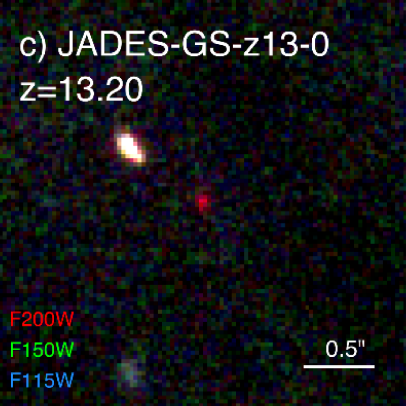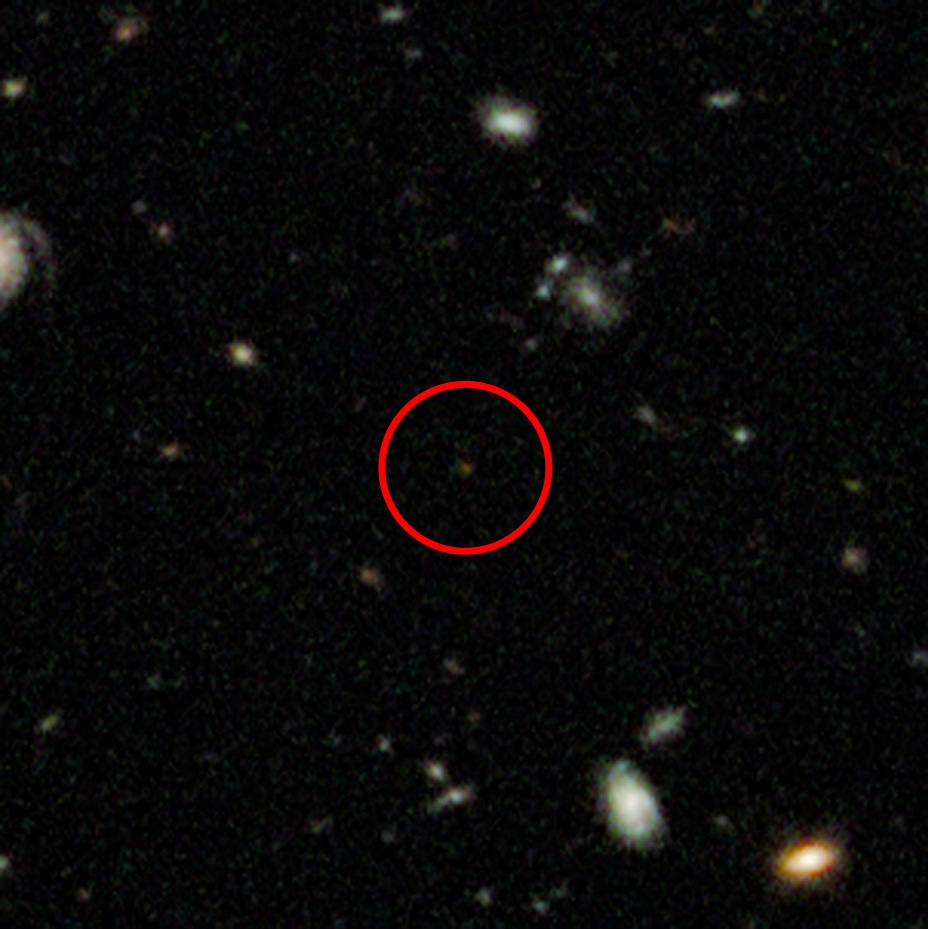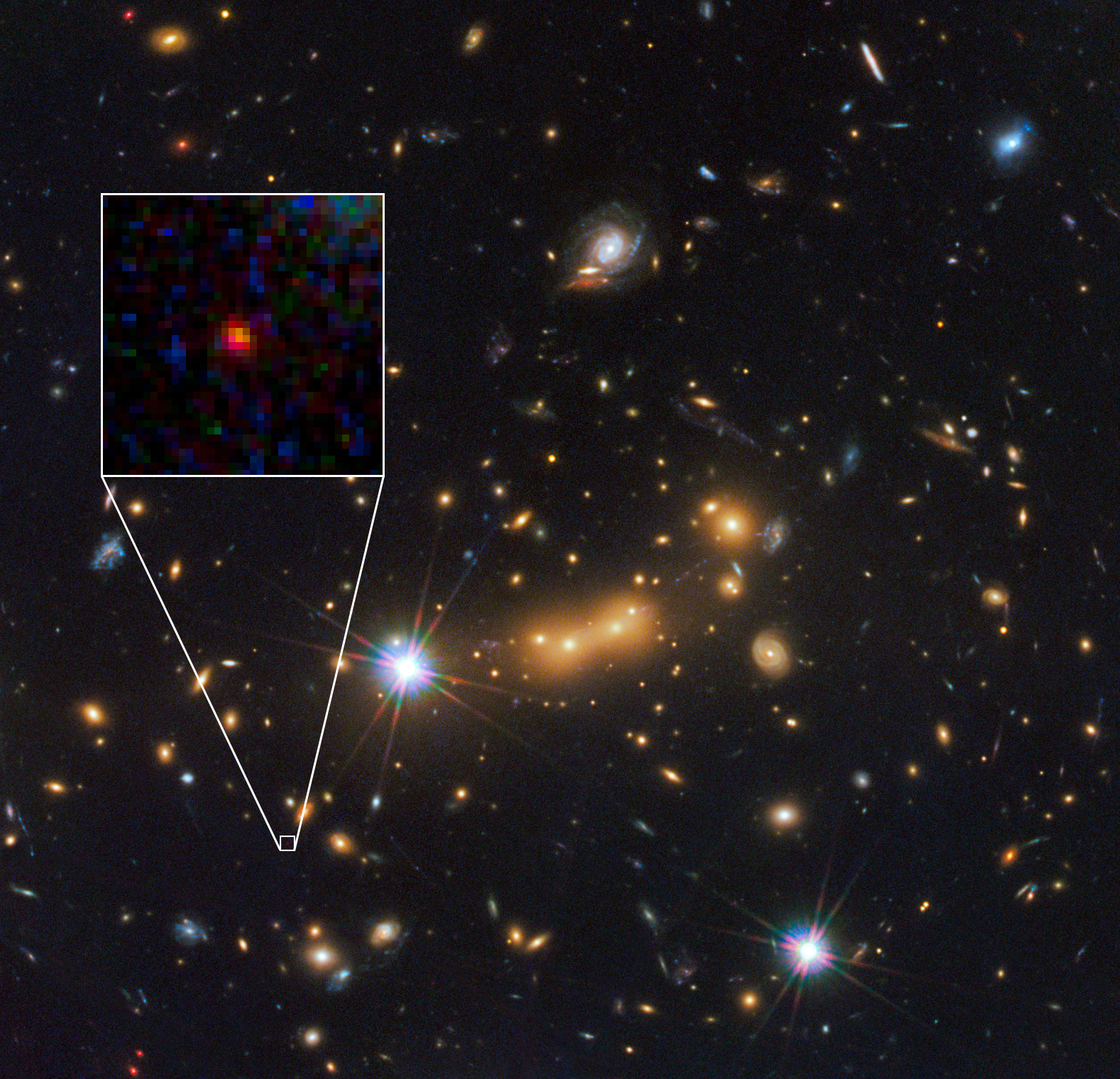|
EGSY8p7
__NOTOC__ EGSY8p7 (EGSY-2008532660) is a distant galaxy in the constellation of Boötes, with a spectroscopic redshift of ''z'' = 8.68 (photometric redshift 8.57), a light travel distance of 13.2 billion light-years from Earth. Therefore, at an age of 13.2 billion years, it is observed as it existed 570 million years after the Big Bang, which occurred 13.8 billion years ago, using the W. M. Keck Observatory. In July 2015, EGSY8p7 was announced as the oldest and most-distant known object, surpassing the previous record holder, EGS-zs8-1, which was determined in May 2015 as the oldest and most distant object. In March 2016, Pascal Oesch, one of the discoverers of EGSY8p7, announced the discovery of GN-z11, an older and more distant galaxy. Detection The light of the EGSY8p7 galaxy appears to have been magnified twofold by gravitational lensing in the light's travel to Earth, enabling the detection of EGSY8p7, which would not have been possible without the magnificatio ... [...More Info...] [...Related Items...] OR: [Wikipedia] [Google] [Baidu] |
GN-z11
GN-z11 is a high-redshift galaxy found in the constellation Ursa Major. It is one of the farthest known galaxies from Earth ever discovered. The 2015 discovery was published in a 2016 paper headed by Pascal Oesch and Gabriel Brammer (Cosmic Dawn Center). Up until the discovery of HD1 in 2022, GN-z11 was the oldest and most distant known galaxy yet identified in the observable universe, having a spectroscopic redshift of , which corresponds to a proper distance of approximately .At first glance, the distance of might seem impossibly far away in a Universe that is only 13.8 billion (short scale) years old, where a light-year is the distance light travels in a year, and where nothing can travel faster than the speed of light. However, because of the expansion of the universe, the distance of 2.66 billion light-years between GN-z11 and the Milky Way at the time when the light was emitted increased by a factor of (z+1)=12.1 to a distance of 32.2 billion light-years during the 13. ... [...More Info...] [...Related Items...] OR: [Wikipedia] [Google] [Baidu] |
List Of The Most Distant Astronomical Objects
This article documents the most distant astronomical objects discovered and verified so far, and the time periods in which they were so classified. For comparisons with the light travel distance of the astronomical objects listed below, the age of the universe since the Big Bang is currently estimated as 13.787±0.020 Gyr. Distances to remote objects, other than those in nearby galaxies, are nearly always inferred by measuring the cosmological redshift of their light. By their nature, very distant objects tend to be very faint, and these distance determinations are difficult and subject to errors. An important distinction is whether the distance is determined via spectroscopy or using a photometric redshift technique. The former is generally both more precise and also more reliable, in the sense that photometric redshifts are more prone to being wrong due to confusion with lower redshift sources that may have unusual spectra. For that reason, a spectroscopic redshift is conventio ... [...More Info...] [...Related Items...] OR: [Wikipedia] [Google] [Baidu] |
EGS-zs8-1
EGS-zs8-1 is a high-redshift Lyman-break galaxy found at the northern constellation of Boötes. In May 2015, EGS-zs8-1 had the highest spectroscopic redshift of any known galaxy, meaning EGS-zs8-1 was the most distant and the oldest galaxy observed. In July 2015, EGS-zs8-1 was surpassed by EGSY8p7 (EGSY-2008532660). Description The redshift of EGS-zs8-1 was measured at z = 7.73, corresponding to a light travel distance of about 13.040 billion light years from Earth, and age of 13.04 billion years. The galaxy shows a high rate of star formation, so it releases its peak radiation at the vacuum ultraviolet part of the electromagnetic spectrum, near the Lyman-alpha emission line due to the intense radiation from newly formed blue stars, hence it is classified as a Lyman-break galaxy; high-redshift starburst galaxies emitting the Lyman-alpha emission line. Because of the cosmological redshift effect caused by the metric expansion of space, the peak light from the galaxy has becom ... [...More Info...] [...Related Items...] OR: [Wikipedia] [Google] [Baidu] |
List Of Galaxies
The following is a list of notable galaxies. There are about 51 galaxies in the Local Group (see list of nearest galaxies for a complete list), on the order of 100,000 in the Local Supercluster, and an estimated 100 billion in all of the observable universe. The discovery of the nature of galaxies as distinct from other nebulae (interstellar clouds) was made in the 1920s. The first attempts at systematic catalogues of galaxies were made in the 1960s, with the Catalogue of Galaxies and Clusters of Galaxies listing 29,418 galaxies and galaxy clusters, and with the Morphological Catalogue of Galaxies, a putatively complete list of galaxies with photographic magnitude above 15, listing 30,642. In the 1980s, the Lyons Groups of Galaxies listed 485 galaxy groups with 3,933 member galaxies. Galaxy Zoo is a project aiming at a more comprehensive list: launched in July 2007, it has classified over one million galaxy images from The Sloan Digital Sky Survey, The Hubble Space Telescope ... [...More Info...] [...Related Items...] OR: [Wikipedia] [Google] [Baidu] |
GRB 090423
GRB 090423 was a gamma-ray burst (GRB) detected by the Swift Gamma-Ray Burst Mission on April 23, 2009 at 07:55:19 UTC whose afterglow was detected in the infrared and enabled astronomers to determine that its redshift is ''z'' = 8.2, which makes it one of the most distant objects detected to date with a spectroscopic redshift ( GN-z11, discovered in 2016, has a redshift of 11). A gamma-ray burst is an extremely luminous event flash of gamma rays that occurs as the result of an explosion, and is thought to be associated with the formation of a black hole. The burst itself typically only lasts for a few seconds, but gamma-ray bursts frequently produce an "afterglow" at longer wavelengths that can be observed for many hours or even days after the burst. Measurements at these wavelengths, which include X-ray, ultraviolet, optical, infrared, and radio, enable follow up study of the event. The finite speed of light means that GRB 090423 is also one of the earliest objects ... [...More Info...] [...Related Items...] OR: [Wikipedia] [Google] [Baidu] |
Hubble Space Telescope
The Hubble Space Telescope (often referred to as HST or Hubble) is a space telescope that was launched into low Earth orbit in 1990 and remains in operation. It was not the first space telescope, but it is one of the largest and most versatile, renowned both as a vital research tool and as a public relations boon for astronomy. The Hubble telescope is named after astronomer Edwin Hubble and is one of NASA's Great Observatories. The Space Telescope Science Institute (STScI) selects Hubble's targets and processes the resulting data, while the Goddard Space Flight Center (GSFC) controls the spacecraft. Hubble features a mirror, and its five main instruments observe in the ultraviolet, visible, and near-infrared regions of the electromagnetic spectrum. Hubble's orbit outside the distortion of Earth's atmosphere allows it to capture extremely high-resolution images with substantially lower background light than ground-based telescopes. It has recorded some of the most detaile ... [...More Info...] [...Related Items...] OR: [Wikipedia] [Google] [Baidu] |
Hydrogen
Hydrogen is the chemical element with the symbol H and atomic number 1. Hydrogen is the lightest element. At standard conditions hydrogen is a gas of diatomic molecules having the formula . It is colorless, odorless, tasteless, non-toxic, and highly combustible. Hydrogen is the most abundant chemical substance in the universe, constituting roughly 75% of all normal matter.However, most of the universe's mass is not in the form of baryons or chemical elements. See dark matter and dark energy. Stars such as the Sun are mainly composed of hydrogen in the plasma state. Most of the hydrogen on Earth exists in molecular forms such as water and organic compounds. For the most common isotope of hydrogen (symbol 1H) each atom has one proton, one electron, and no neutrons. In the early universe, the formation of protons, the nuclei of hydrogen, occurred during the first second after the Big Bang. The emergence of neutral hydrogen atoms throughout the universe occurred about 370,000 ... [...More Info...] [...Related Items...] OR: [Wikipedia] [Google] [Baidu] |
The Astrophysical Journal
''The Astrophysical Journal'', often abbreviated ''ApJ'' (pronounced "ap jay") in references and speech, is a peer-reviewed Peer review is the evaluation of work by one or more people with similar competencies as the producers of the work (peers). It functions as a form of self-regulation by qualified members of a profession within the relevant field. Peer review ... scientific journal of astrophysics and astronomy, established in 1895 by American astronomers George Ellery Hale and James Edward Keeler. The journal discontinued its print edition and became an electronic-only journal in 2015. Since 1953 ''The Astrophysical Journal Supplement Series'' (''ApJS'') has been published in conjunction with ''The Astrophysical Journal'', with generally longer articles to supplement the material in the journal. It publishes six volumes per year, with two 280-page issues per volume. ''The Astrophysical Journal Letters'' (''ApJL''), established in 1967 by Subrahmanyan Chandrasekhar as ... [...More Info...] [...Related Items...] OR: [Wikipedia] [Google] [Baidu] |
UDFy-38135539
UDFy-38135539 (also known as "HUDF.YD3") is the Hubble Ultra Deep Field (UDF) identifier for a galaxy which was calculated to have a light travel time of 13.1 billion years with a present proper distance of around 30 billion light-years. It was discovered by three teams in September 2009 in sensitive infrared Hubble Space Telescope images and identified by these as source UDF-38135539 ( R Bouwens ''et al.''), source HUDF.YD3 (A Bunker ''et al.'') and source 1721 (R McLure ''et al.''), and additionally reported in the ''Astrophysical Journal'', and the ''Monthly Notices of the Royal Astronomical Society''. All teams independently identified the source to likely be an extremely distant galaxy because there was no measurable light at visible wavelengths (caused by absorption of hydrogen gas along the line of sight). Following the discovery of this candidate distant galaxy, another team targeted this object with ground-based spectroscopy to confirm the distance, reporting a reds ... [...More Info...] [...Related Items...] OR: [Wikipedia] [Google] [Baidu] |
MACS0647-JD
__NOTOC__ MACS0647-JD is a galaxy with a redshift of about ''z'' = 10.7, equivalent to a light travel distance of 13.26 billion light-years (4 billion parsecs). If the distance estimate is correct, it formed about 427 million years after the Big Bang. Details JD refers to ''J-band Dropout'' – the galaxy was not detected in the so-called J-band (F125W), nor in 14 bluer Hubble filters. It only appeared in the two reddest filters (F140W and F160W). It is less than 600 light-years wide, and contains roughly a billion stars. The galaxy was discovered with the help of Cluster Lensing And Supernova survey with Hubble (CLASH), which uses massive galaxy clusters as cosmic telescopes to magnify distant galaxies behind them, an effect called gravitational lensing. Observations were recorded by the Wide Field Camera 3 on the Hubble Space Telescope, with support from Spitzer Space Telescope. The location of the galaxy is in the constellation Camelopardalis, which is also the location of ... [...More Info...] [...Related Items...] OR: [Wikipedia] [Google] [Baidu] |
Caltech
The California Institute of Technology (branded as Caltech or CIT)The university itself only spells its short form as "Caltech"; the institution considers other spellings such a"Cal Tech" and "CalTech" incorrect. The institute is also occasionally referred to as "CIT", most notably in its alma mater, but this is uncommon. is a private university, private research university in Pasadena, California. Caltech is ranked among the best and most selective academic institutions in the world, and with an enrollment of approximately 2400 students (acceptance rate of only 5.7%), it is one of the world's most selective universities. The university is known for its strength in science and engineering, and is among a small group of Institute of Technology (United States), institutes of technology in the United States which is primarily devoted to the instruction of pure and applied sciences. The institution was founded as a preparatory and vocational school by Amos G. Throop in 1891 and began ... [...More Info...] [...Related Items...] OR: [Wikipedia] [Google] [Baidu] |
Huffington Post
''HuffPost'' (formerly ''The Huffington Post'' until 2017 and sometimes abbreviated ''HuffPo'') is an American progressive news website, with localized and international editions. The site offers news, satire, blogs, and original content, and covers politics, business, entertainment, environment, technology, popular media, lifestyle, culture, comedy, healthy living, women's interests, and local news featuring columnists. It was created to provide a progressive alternative to the conservative news websites such as the Drudge Report. The site offers content posted directly on the site as well as user-generated content via video blogging, audio, and photo. In 2012, the website became the first commercially run United States digital media enterprise to win a Pulitzer Prize. Founded by Andrew Breitbart, Arianna Huffington, Kenneth Lerer, and Jonah Peretti, the site was launched on May 9, 2005 as a counterpart to the Drudge Report. In March 2011, it was acquired by AOL for US$315&n ... [...More Info...] [...Related Items...] OR: [Wikipedia] [Google] [Baidu] |





.jpg)